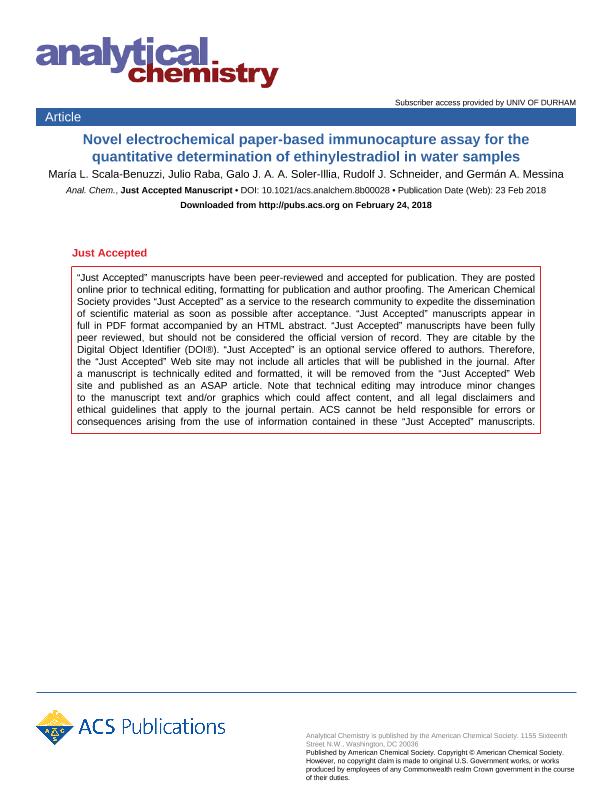Mostrar el registro sencillo del ítem
dc.contributor.author
Scala Benuzzi, María Luz

dc.contributor.author
Raba, Julio

dc.contributor.author
Soler Illia, Galo Juan de Avila Arturo

dc.contributor.author
Schneider, Rudolf J.
dc.contributor.author
Messina, Germán Alejandro

dc.date.available
2019-10-25T23:23:49Z
dc.date.issued
2018-03-23
dc.identifier.citation
Scala Benuzzi, María Luz; Raba, Julio; Soler Illia, Galo Juan de Avila Arturo; Schneider, Rudolf J.; Messina, Germán Alejandro; Novel Electrochemical Paper-Based Immunocapture Assay for the Quantitative Determination of Ethinylestradiol in Water Samples; American Chemical Society; Analytical Chemistry; 90; 6; 23-3-2018; 4104-4111
dc.identifier.issn
0003-2700
dc.identifier.uri
http://hdl.handle.net/11336/87359
dc.description.abstract
We report a novel and innovative electrochemical paper-based immunocapture assay (EPIA) to address the need for ultrasensitive detection of emerging pollutants without regulatory status and whose effects on environment and human health are not completely yet understood. In particular, we present the application of this system toward highly sensitive detection of the emerging pollutant ethinyl estradiol (EE2). The EPIA approach is based on the use of paper microzones modified with silica nanoparticles (SNs) and anti-EE2 specific antibodies for capture and preconcentration of EE2 from river water samples. After the preconcentration procedure, the paper microzones are placed onto a screen-printed carbon electrode modified with electrochemically reduced graphene (RG). The bound EE2 is subsequently desorbed adding a diluted solution of sulfuric acid on the paper microzones. Finally, recovered EE2 is electrochemically detected by OSWV. The proposed novel methodology showed an appropriate LOD and linear range for the quantification of EE2 for water samples with different origins. The nonsophisticated equipment required, the adequate recovery values obtained (from 97% to 104%, with a RSD less than 4.9%), and the appropriate LOD and linear range value (0.1 ng L-1 and 0.5-120 ng L-1, respectively) achieved by our immunocapture sensor present significant analytical figures of merit, particularly when the routine quantification of EE2 is considered. In addition, our system was based on electrochemical paper-based technology, which allows obtainment of portable, easy-to-use, inexpensive, and disposable devices. The EPIA can also serve as a general-purpose immunoassay platform applicable to quantitation of other drugs and emerging pollutants in environmental samples.
dc.format
application/pdf
dc.language.iso
eng
dc.publisher
American Chemical Society

dc.rights
info:eu-repo/semantics/openAccess
dc.rights.uri
https://creativecommons.org/licenses/by/2.5/ar/
dc.subject
Electrochemical paper-based immunocapture assay
dc.subject
Ethinylestradiol
dc.subject
Water samples
dc.subject.classification
Química Analítica

dc.subject.classification
Ciencias Químicas

dc.subject.classification
CIENCIAS NATURALES Y EXACTAS

dc.title
Novel Electrochemical Paper-Based Immunocapture Assay for the Quantitative Determination of Ethinylestradiol in Water Samples
dc.type
info:eu-repo/semantics/article
dc.type
info:ar-repo/semantics/artículo
dc.type
info:eu-repo/semantics/publishedVersion
dc.date.updated
2019-10-21T19:48:59Z
dc.journal.volume
90
dc.journal.number
6
dc.journal.pagination
4104-4111
dc.journal.pais
Estados Unidos

dc.journal.ciudad
Washington DC
dc.description.fil
Fil: Scala Benuzzi, María Luz. Consejo Nacional de Investigaciones Científicas y Técnicas. Centro Científico Tecnológico Conicet - San Luis. Instituto de Química de San Luis. Universidad Nacional de San Luis. Facultad de Química, Bioquímica y Farmacia. Instituto de Química de San Luis; Argentina
dc.description.fil
Fil: Raba, Julio. Consejo Nacional de Investigaciones Científicas y Técnicas. Centro Científico Tecnológico Conicet - San Luis. Instituto de Química de San Luis. Universidad Nacional de San Luis. Facultad de Química, Bioquímica y Farmacia. Instituto de Química de San Luis; Argentina
dc.description.fil
Fil: Soler Illia, Galo Juan de Avila Arturo. Consejo Nacional de Investigaciones Científicas y Técnicas; Argentina. Universidad Nacional de San Martin. Instituto de Nanosistemas; Argentina
dc.description.fil
Fil: Schneider, Rudolf J.. Bundesanstalt für Materialforschung und -prüfung; Alemania
dc.description.fil
Fil: Messina, Germán Alejandro. Consejo Nacional de Investigaciones Científicas y Técnicas. Centro Científico Tecnológico Conicet - San Luis. Instituto de Química de San Luis. Universidad Nacional de San Luis. Facultad de Química, Bioquímica y Farmacia. Instituto de Química de San Luis; Argentina
dc.journal.title
Analytical Chemistry

dc.relation.alternativeid
info:eu-repo/semantics/altIdentifier/url/https://pubs.acs.org/doi/10.1021/acs.analchem.8b00028
dc.relation.alternativeid
info:eu-repo/semantics/altIdentifier/doi/https://doi.org/10.1021/acs.analchem.8b00028
Archivos asociados
